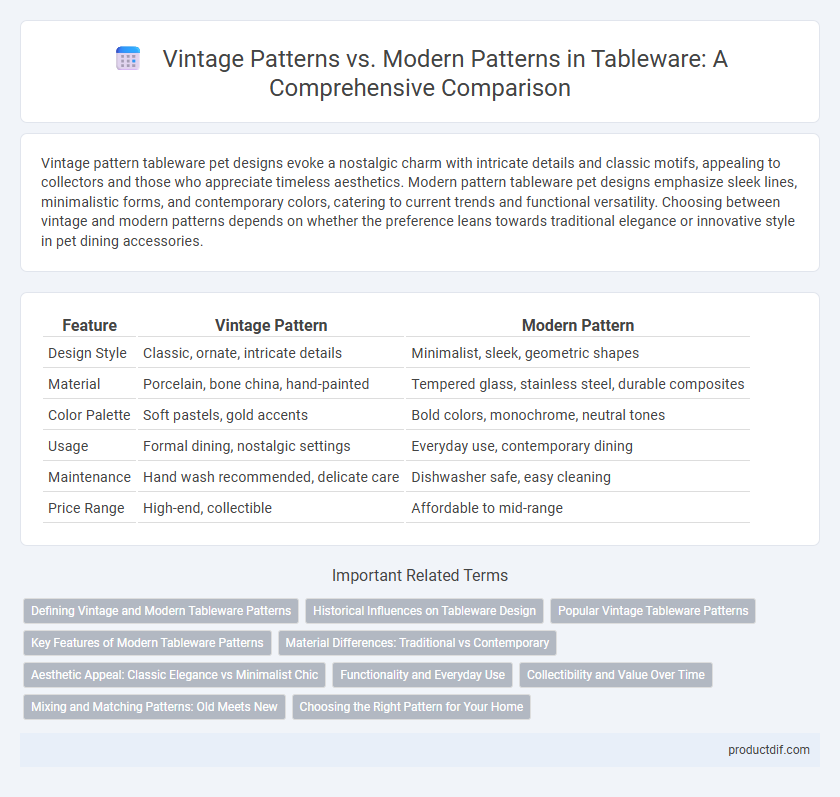Vintage pattern tableware pet designs evoke a nostalgic charm with intricate details and classic motifs, appealing to collectors and those who appreciate timeless aesthetics. Modern pattern tableware pet designs emphasize sleek lines, minimalistic forms, and contemporary colors, catering to current trends and functional versatility. Choosing between vintage and modern patterns depends on whether the preference leans towards traditional elegance or innovative style in pet dining accessories.
Table of Comparison
| Feature | Vintage Pattern | Modern Pattern |
|---|---|---|
| Design Style | Classic, ornate, intricate details | Minimalist, sleek, geometric shapes |
| Material | Porcelain, bone china, hand-painted | Tempered glass, stainless steel, durable composites |
| Color Palette | Soft pastels, gold accents | Bold colors, monochrome, neutral tones |
| Usage | Formal dining, nostalgic settings | Everyday use, contemporary dining |
| Maintenance | Hand wash recommended, delicate care | Dishwasher safe, easy cleaning |
| Price Range | High-end, collectible | Affordable to mid-range |
Defining Vintage and Modern Tableware Patterns
Vintage tableware patterns are characterized by ornate designs, often featuring floral motifs, intricate detailing, and muted color palettes reflecting styles from the early to mid-20th century. Modern tableware patterns emphasize minimalist aesthetics, clean lines, and bold or pastel colors, showcasing contemporary design trends that prioritize functionality and simplicity. Defining these patterns involves recognizing vintage's nostalgic elegance and handcrafted appeal versus modern's sleek, innovative, and often mass-produced qualities.
Historical Influences on Tableware Design
Vintage tableware patterns often reflect the artistic and cultural movements of their time, such as Victorian floral motifs or Art Deco geometric designs, embodying historical craftsmanship and tradition. Modern patterns prioritize minimalism and functional aesthetics, influenced by contemporary design philosophies and advancements in manufacturing technology. The evolution from ornate vintage styles to sleek modern designs highlights shifting societal values and technological progress within tableware production.
Popular Vintage Tableware Patterns
Popular vintage tableware patterns like Blue Willow, Johnson Brothers' "Friendly Village," and Royal Albert's "Old Country Roses" remain highly sought after for their intricate designs and nostalgic appeal. These patterns often feature floral motifs, pastoral scenes, and classic color palettes that evoke a sense of timeless elegance. In contrast, modern patterns tend to emphasize minimalism and bold geometric shapes, reflecting contemporary design trends.
Key Features of Modern Tableware Patterns
Modern tableware patterns emphasize minimalistic designs, clean lines, and geometric shapes that cater to contemporary aesthetics. They often incorporate bold colors and abstract motifs, reflecting current trends in interior decor. Durable materials like porcelain and stoneware enhance both functionality and visual appeal in modern tableware collections.
Material Differences: Traditional vs Contemporary
Vintage pattern tableware often features materials like porcelain, bone china, and stoneware that emphasize durability and classic craftsmanship. Modern pattern tableware incorporates contemporary materials such as tempered glass, melamine, and stainless steel, offering enhanced lightweight design and increased resistance to chips and scratches. These material differences reflect the shift from traditional, handcrafted elegance to innovative, practical functionality in tableware production.
Aesthetic Appeal: Classic Elegance vs Minimalist Chic
Vintage pattern tableware showcases intricate designs and ornate detailing, evoking a sense of classic elegance ideal for traditional or formal dining settings. Modern pattern tableware emphasizes clean lines and simplicity, reflecting minimalist chic that complements contemporary interiors and everyday use. Both styles enhance table aesthetics but cater to distinct visual preferences and atmospheres.
Functionality and Everyday Use
Vintage pattern tableware often features intricate designs and heavier materials, which can add aesthetic charm but may limit practicality for everyday use due to fragility and weight. Modern pattern tableware prioritizes minimalistic designs and lightweight, durable materials like melamine or tempered glass, enhancing functionality and ease of cleaning. For daily use, modern patterns offer better resistance to chips and stains, making them more suitable for busy households.
Collectibility and Value Over Time
Vintage pattern tableware often holds higher collectibility and value over time due to its historical significance, craftsmanship, and rarity, attracting collectors who seek authentic designs from specific eras. Modern patterns may appeal more for everyday use and contemporary aesthetics but generally appreciate less in monetary value unless linked to limited editions or renowned designers. The market trend shows increasing interest in vintage tableware as nostalgic and authentic pieces become scarcer, driving demand and price appreciation.
Mixing and Matching Patterns: Old Meets New
Mixing and matching vintage patterns with modern designs creates a dynamic tableware aesthetic that blends timeless elegance with contemporary flair. Layering floral vintage motifs alongside sleek geometric modern patterns enhances visual interest and adds depth to dining experiences. Combining these diverse elements encourages personalization, making every table setting uniquely expressive and stylish.
Choosing the Right Pattern for Your Home
Choosing the right tableware pattern for your home depends on your interior style and personal taste. Vintage patterns often feature intricate floral or geometric designs that evoke nostalgia and elegance, making them ideal for traditional or eclectic decor. Modern patterns emphasize clean lines, minimalism, and bold colors, complementing contemporary spaces with a sleek and sophisticated aesthetic.
Vintage Pattern vs Modern Pattern Infographic

 productdif.com
productdif.com